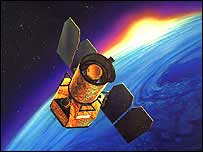Looking for the first stars - the Galaxy Evolution Explorer spacecraft (Galex), which was designed to discover stars formed in the early universe, was launched from a Pegasus rocket released from a transport plane near the Florida coast
 The small satellite will observe millions of galaxies throughout 10 billion years of cosmic history and help astronomers decide when the chemical elements inside the first stars were formed.
The small satellite will observe millions of galaxies throughout 10 billion years of cosmic history and help astronomers decide when the chemical elements inside the first stars were formed.
The satellite will map the first stages of the chemical evolution of the universe from the fireball made of hydrogen to the heavy elements.
To some extent this is the search for the source of life, because without the heavy elements like carbon and oxygen life as we know it would not exist.
After the satellite separated from the third stage of the rocket, 11 minutes and five seconds after being released from the transport plane, it entered orbit at an altitude of 690 kilometers. At the end of a month of tests, the scientific mission will begin, which will last up to 28 months.
Galax will focus on galaxies that contain young, hot stars that are also short-lived and emit a lot of radiation in the ultraviolet range. Astronomers are drawn to these galaxies because star formation is an activity that, if studied, can help astronomers learn more about how stars form and why they form in the first place.
The mission will provide the most comprehensive map yet of the universe and galaxies in formation and bring us closer to understanding how the Milky Way was formed, says Christopher Maritin, Galax principal investigator.
"Galaxy was specifically designed to measure the distance and rate of star formation in a million galaxies," said NASA astronomer James Penson.
"This may help us put together a picture of the universe we see today - how the stars formed in the galaxies, how the galaxies evolved over time, what causes the stars to form and what led to the development of the heavy elements in the periodic table." added "As a project manager, there are few career opportunities to be associated with a mission that will provide fundamental information of the universe.
"Typically, when you see the universe for the first time in a new way, there are unexpected surprises that come from the data. So we expect these surprises."
The Galax mission was the 22nd Pegasus mission and the second of 4 planned in 2003.
